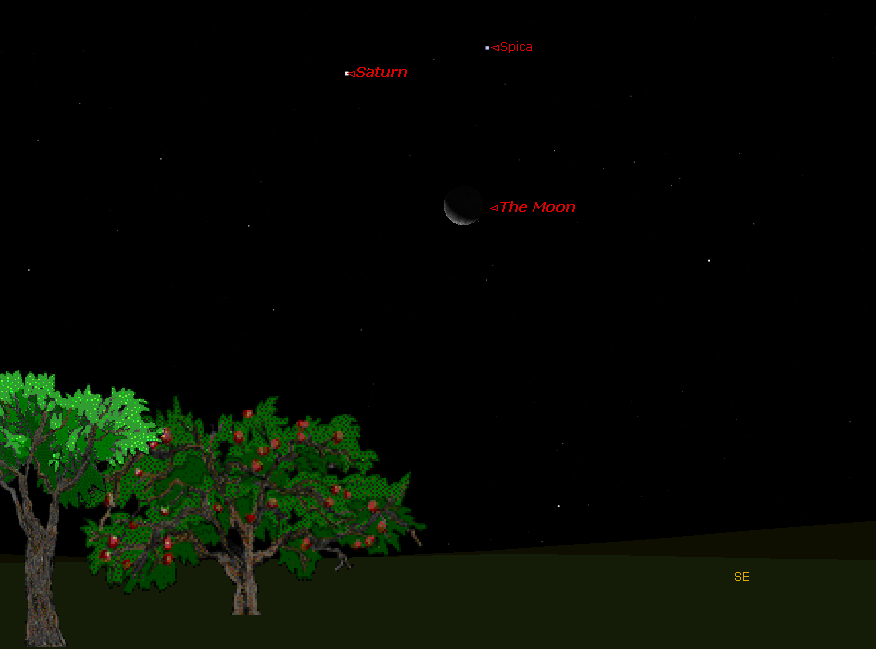Saturn Forms Sky Triangle with Moon & Star Early Tuesday

Early-bird skywatchers who awake well before sunrise on Tuesday (Dec. 20) will have an interesting celestial array to admire, composed of the moon, a bright planet and a bright star. The configuration will resemble a rather large triangle low to the east-southeast horizon.
Along with the moon — which is not quite one-quarter lit and reduced to its waning crescent phase — will be the planet Saturn, shining sedately with a yellowish-white glow well above and to the left of the moon. Hovering above and to the right of the moon will be the bright bluish star Spica, in the zodiacal constellation of Virgo. The moon, of course appears to pass Spica every month, but as was also the case last winter, Saturn happens to be nearby too, so I've taken to calling this arrangement the "Saturn Triangle."
This sky map of the Saturn Triangle shows how Saturn, the moon and Spica will be arranged before sunrise on Tuesday. If weather permits, skywatchers can start looking for the moon-planet-star pattern at around 3 a.m. (Local Time).
By around 5:30 a.m., just as dawn is about to break, the trio will have moved to a point about one-quarter of the way up in the southeast sky. But the triangle will also look a bit different.
Saturn is currently 942 million miles (1.515 billion kilometers) from Earth and will not change its position relative to the background stars during the course of a single night. But the moon is only 226,000 miles (364,000 km) away.
As a result, the moon will slowly shift its position to the east during the course of the night. The moon appears to move east against the background stars at roughly its own apparent width (about 1/2 of a degree) per hour. In fact, in only about three hours after the Saturn Triangle's first appearance, the moon will have appeared to move about 1 1/2 degrees farther to the east making the formation resemble an isosceles triangle.
What makes this triangle an isosceles (a triangle with at least two equal sides) is that the moon will be located at an equal distance from both Saturn and Spica: nearly 8 degrees. Your clenched fist held out at arm's length covers about 10 degrees of the night sky, sothe Saturn-moon and Spica-moon sides of the triangle will be slightly less than a fist's width in length. The side of the triangle from Saturn to Spica will measure just 6 degrees.
Breaking space news, the latest updates on rocket launches, skywatching events and more!
Saturn is about 30 percent brighter than Spica and if you have a small or medium-size telescope, check out Saturn's rings. During the late summer of 2008, Saturn's rings were all but invisible to us because they were turned edge-on (or nearly so) toward earth. Now, however, they are tilted just over 14 degrees toward us, and are readily seen if you are using a magnification of at least 30-power.
Joe Rao serves as an instructor and guest lecturer at New York's Hayden Planetarium. He writes about astronomy for The New York Times and other publications, and he is also an on-camera meteorologist for News 12 Westchester, New York.

Joe Rao is Space.com's skywatching columnist, as well as a veteran meteorologist and eclipse chaser who also serves as an instructor and guest lecturer at New York's Hayden Planetarium. He writes about astronomy for Natural History magazine, Sky & Telescope and other publications. Joe is an 8-time Emmy-nominated meteorologist who served the Putnam Valley region of New York for over 21 years. You can find him on Twitter and YouTube tracking lunar and solar eclipses, meteor showers and more. To find out Joe's latest project, visit him on Twitter.
